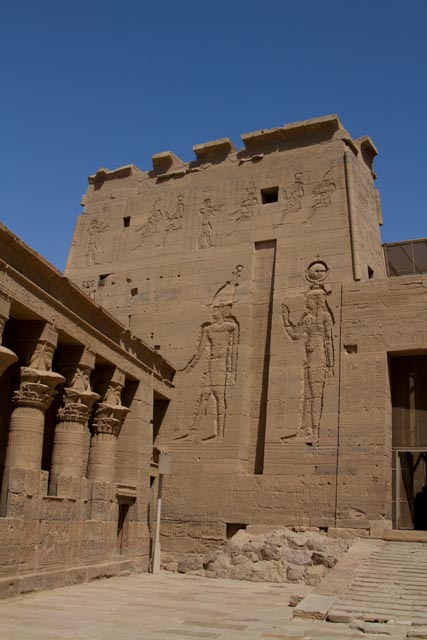
Isis is a goddess in Ancient Egyptian religious beliefs, whose worship spread throughout the Greco-Roman world. She was worshipped as the ideal mother and wife as well as the patroness of nature and magic. She was the friend of slaves, sinners, artisans, and the downtrodden, and she listened to the prayers of the wealthy, maidens, aristocrats, and rulers. Isis is often depicted as the mother of Horus, the hawk-headed god of war and protection (although in some traditions Horus’s mother was Hathor). Isis is also known as protector of the dead and goddess of children.
The name Isis means, “Throne”. Her headdress is a throne. As the personification of the throne, she was an important representation of the pharaoh’s power. The pharaoh was depicted as her child, who sat on the throne she provided. Her cult was popular throughout Egypt, but her most important temple remaining is on the island of Philae in Upper Egypt.
In the typical form of her myth, Isis was the first daughter of Geb, god of the Earth, and Nut, goddess of the Sky, and she was born on the fourth intercalary day. She married her brother, Osiris, and she conceived Horus with him. Isis was instrumental in the resurrection of Osiris when he was murdered by Set. Using her magical skills, she restored his body to life after having gathered the body parts that had been strewn about the earth by Set.
This myth became very important during the Greco-Roman period. For example it was believed that the Nile River flooded every year because of the tears of sorrow that Isis wept for Osiris. Osiris’s death and rebirth was relived each year through rituals. The worship of Isis eventually spread throughout the Greco-Roman world, continuing until the suppression of paganism in the Christian era
For more information about Philae Temple
- 2014-03-20 – Unfinished Obelisk, High Dam, Philae Temple, High Tea
- Egyptian Goddess – Hathor
- Egyptian Goddess – Isis
- Egyptian Mythology – Horus
- Philae Temple
- Philae Temple – Part 1- Overview
- Philae Temple – Part 2 – Introduction
- Philae Temple – Part 3 – History
- Philae Temple – Part 4 – What to See
- Philae Temple – Part 5 – What to See
- Philae Temple – Part 6 – Our Experience
For more information about Egyptian Mythology
- Egyptian Crocodile God – Sobek
- Egyptian Goddess – Hathor
- Egyptian Goddess – Isis
- Egyptian Mythology – Horus
